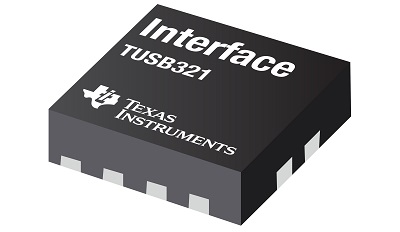This post sponsored by Texas Instruments.
The TUSB321 device enables USB Type-C ports with the configuration channel (CC) logic needed for Type-C ecosystems.

The TUSB321 device uses the CC pins to determine port attach and detach, cable orientation, role detection, and port control for Type-C current mode. It can be configured as a downstream facing port (DFP), upstream facing port (UFP) or a dual role port (DRP), making it ideal for any application.
TI's TUSB321 device when configured as a DRP alternates configuration as a DFP or UFP according to the Type-C specifications. The CC logic block monitors the CC1 and CC2 pins for pull-up or pull-down resistances to determine when a USB port has been attached, the orientation of the cable, and the role detected. The CC logic detects the Type-C current mode as default, medium, or high depending on the role detected. VBUS detection is implemented to determine a successful attachment in UFP and DRP modes. Finally, the device operates over a wide supply range and has low-power consumption.
The TUSB321 device is available in industrial and commercial temperature ranges. It may be used for host, device, dual role port, and mobile phone applications, as well as tablets, notebooks, and USB peripherals.
By: Rachel Kalina
For more information about this product, click here.
For detailed information about the tool mentioned above, click here.
To request a sample, click here.
To download a datasheet, click here.

To buy now at Mouser, click here.
Advertisement
Learn more about Texas Instruments





